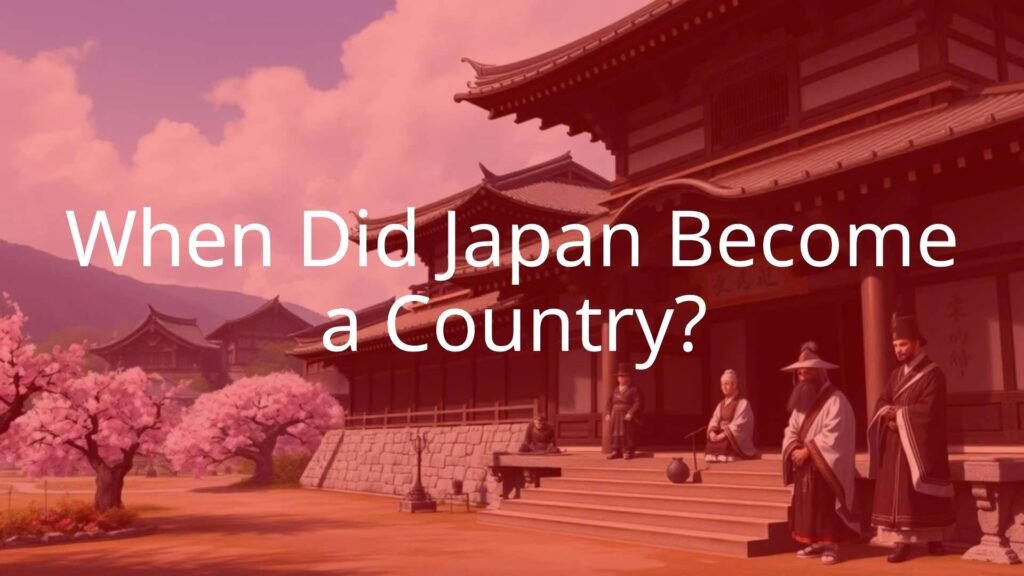Japan, often called the “Land of the Rising Sun,” has a deep and layered history. It’s hard to decide on a specific moment when Japan truly “became a country,” since building a nation doesn’t happen overnight. Instead, it was a step-by-step process that happened over centuries. But if we look for a key time when Japan started to be united with a central government and an emperor, we find that the early centuries of the Common Era-especially during the growth of the Yamato kingdom and the system changes in the Asuka and Nara times-are the most important. These periods started the story of Japan as a nation.

What Does It Mean for Japan to Become a Country?
How Do We Define a Country?
Defining a country is not always easy, especially when we look back thousands of years. Usually, a country means a place with borders, people who live there all the time, a government that has control, and the ability to talk to other countries. It’s about people coming together with shared rules and leaders. For Japan, this wasn’t a single event, but a slow growth. Various regional groups over time built up first simple, then more complex government systems, and learned to work together. It’s more like coming of age than having a birthday.
Early on, Japan was home to smaller tribal and clan groups. Each had its own land and leader. There was no main government over all the islands. The path to statehood was these clans joining together, sometimes by force. Learning from places like China and Korea helped Japan create better systems and helped speed up the path to becoming one country.
What Were Japan’s First Political Groups?
Before there was a single Japan, groups and clans ruled different areas. In the Jomon period (about 10,000 to 300 BCE), people lived in smaller groups, were mostly hunters and gatherers, and made rope-patterned pottery. They stayed in one place more than before, but these settlements were not joined together under one leader.
Things changed in the Yayoi period (300 BCE-300 CE). New farming and metal tools from China and Korea led to bigger, more settled communities. Rice farming made villages grow and sometimes fight over land. It was during this time that some clans became more powerful than others, which paved the way for Japan’s later unification.

Timeline of Japan’s State Formation
| Period | Main Events | Years |
|---|---|---|
| Jomon | Hunter-gatherers, tribal living, cord-pattern pottery | ~14,500 BCE-900 BCE |
| Yayoi | Rice farming, metal tools, rise of clans | 300 BCE-300 CE |
| Kofun | Large tomb building, growth of Yamato clan | 300-645 CE |
| Asuka & Nara | Formal government, laws, central emperor’s power | 645-794 CE |
| Heian | Court culture, rise of samurai, less central control | 794-1185 CE |
Prehistoric and Jomon Periods: Early Life in Japan
People have lived in Japan for at least 130,000 years, thanks to land connections that came and went with the ice age. The Jomon period lasted from around 14,500 BCE to 900 BCE, known for early communities and pottery made with cords. Even though they built villages, these groups did not create a single government.
Yayoi Period: Farming and Social Change
The Yayoi period brought rice farming and metalworking, which came from outside Japan. This changed life here a lot. Villages started protecting their land with moats and fences, leading to more competition. During this time, the first bigger, more organized groups formed.
Kofun Period: Powerful Clans and Yamato Rule
From 300 to 645 CE, the Kofun age is marked by huge burial mounds for leaders-evidence of large, organized groups. The Yamato clan stood out, claiming they were descended from the sun goddess. This gave them an important place and let them bring more land and people under their control. Written language from China arrived during this period, helping the group keep records and communicate better.

Asuka and Nara Periods: Setting Up Formal Systems
Between 645 and 794 CE, Japan built stronger state systems, copying many things from China. Leaders like Prince Shotoku tried to make a central government and supported Buddhism and Confucian values. The Taika Reforms (645 CE) aimed to bring land, taxes, and power under the emperor. The capital at Nara was built with Chinese city ideas in mind. These steps marked a move toward a single nation with shared laws and leaders.

Heian Period and the Rise of the Samurai
The Heian period (794-1185) saw Japan’s court move to Kyoto and the arts thrive. Japanese culture grew more unique as ties with China faded. However, the emperor’s power dropped as warrior families, or samurai, grew strong. From the late 1100s, real political control was held by the shogun and samurai during the feudal period, not the emperor.
How Was Japan First United?
The Yamato State
The closest point to a united Japan began with the Yamato state in the Kofun period. Before this, many clans ruled their separate lands. The Yamato gained more land and followers, mainly with force or smart marriages. Their claim that their ancestors were gods made them harder to challenge. This was the start of one group having real control and power to unite others.
Central Government and the Imperial Family
With strong influence from China, Japan’s leaders built government systems to help the emperor rule directly, starting with the Taika Reforms. By the Nara period, they had a fixed capital and better control over their people. Books like the Kojiki and Nihon Shoki told the history and stories of the emperor’s family, stressing their right to rule. Although later times saw emperors have less control, this early setup gave Japan a continuous, stable line of rulers.
What Impact Did Foreign Influences Have on Japan?
Learning from China and Korea
Japan copied many ideas from China and Korea, from government to culture. Regular trips sent Japanese people to learn about laws, writing, and ways to organize the country. For example, Japan’s government and even the capital city layout were like those in China. Korea passed along not just ideas but also technology and religion from China.
Buddhism and Writing Come to Japan
Buddhism entered Japan in 552 CE, leading to new temples and cultural changes. It gave leaders new ways to keep order and make people think of Japan as a single place. Chinese characters arrived around the 5th century. Before this, Japan had no writing at all. Writing helped leaders make laws, communicate across the land, and keep historical records, helping the country stick together.

When Was Japan Recognized as a Modern Country?
The Meiji Restoration and Modern Statehood
Japan was already united in many ways for centuries, but modern recognition came with major changes in the Meiji Restoration, starting in 1868. Foreign visitors forced Japan to open up. The feudal samurai system ended fast, and the emperor’s power was brought back (at least on paper). The emperor moved to Tokyo, and Japan wanted to catch up with the West. New laws, a new constitution (1889), and a move to democracy and industrial society quickly followed, giving Japan the systems other countries recognized.

Japan on the World Stage
After modernizing, Japan began to win wars, such as against China (1894-1895) and Russia (1904-1905), and became respected globally. Japan joined major world meetings and signed treaties that confirmed its status. After World War II, Japan adopted a new constitution (1947) and fully regained its independence in 1952. Since then, it has been a member of the United Nations and major world groups like the G7 and G20.
Common Misunderstandings About Japan’s Beginnings
Myth Versus Fact
Japan’s own myths, like those in the Kojiki and Nihon Shoki, say the first emperor, Jimmu, founded the nation in 660 BCE, descended from the sun goddess. While these stories are important to Japanese culture, there is no proof from archaeology or written records until centuries later. The record shows that many groups and clans existed long after 660 BCE, and the united state grew over time, not instantly.
The Truth About Japan’s Emperors
The emperor’s family line is considered unbroken, but the emperor did not always have real control. For hundreds of years, military leaders called shoguns held the power, especially from the 12th century until the 19th century. The emperor often acted as a symbol rather than a real decision-maker, except for some key periods, such as after the Meiji Restoration.
Why Does the Date of Japan’s Unification Matter?
Shaping Japanese Identity
Knowing when Japan became a country is more than a historical question. It helps create a sense of who the Japanese are. The story of a long, unbroken imperial family and ancient past gives people pride and a strong sense of heritage. This story is part of religion, law, and national identity, even if real events were much more complex.
Continuity and Change
Looking at Japan’s state history shows both deep roots and important changes. While the imperial line continued, the type of government and who held real control shifted many times. From independent clans, to a centralized government, back to rule by warlords, and then a modern state, Japan adapted but always held onto its core identity. Studying this journey helps us understand how Japan kept a sense of unity amid all these changes.
- What Is a Maiko? - July 13, 2025
- What Does Domo Arigato Mean? - July 12, 2025
- What Does Naruto Mean? - July 12, 2025









